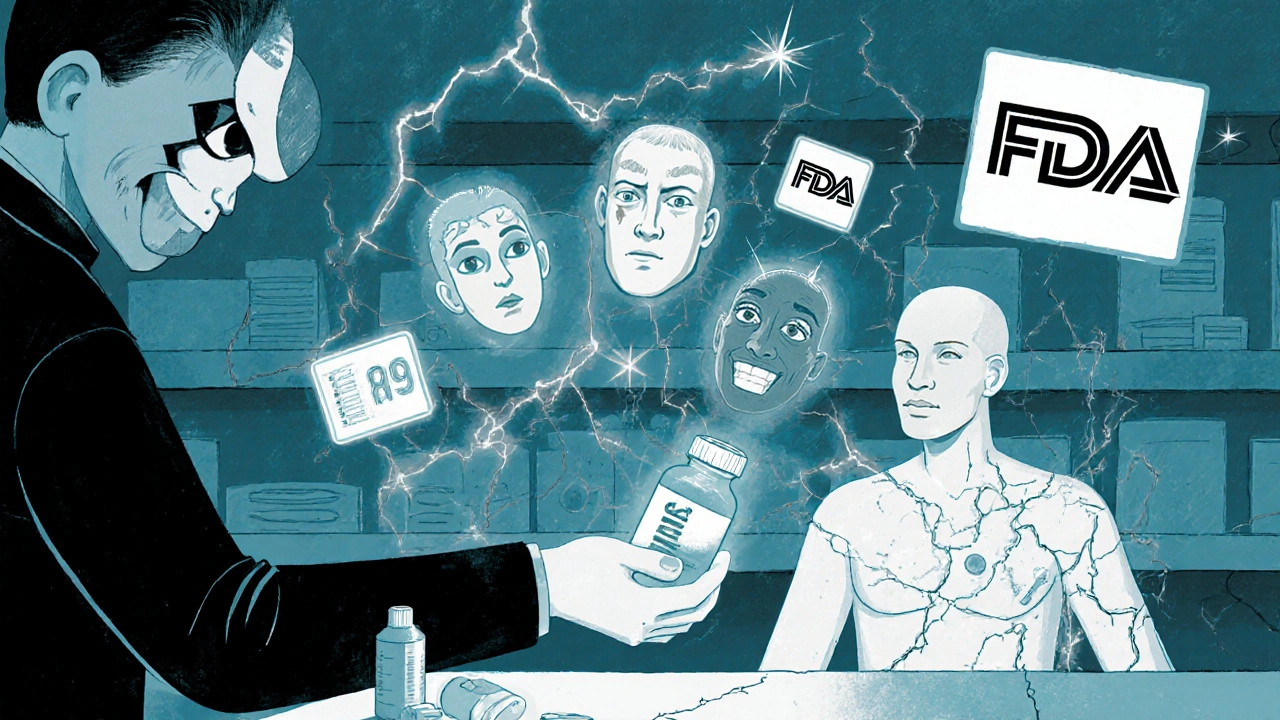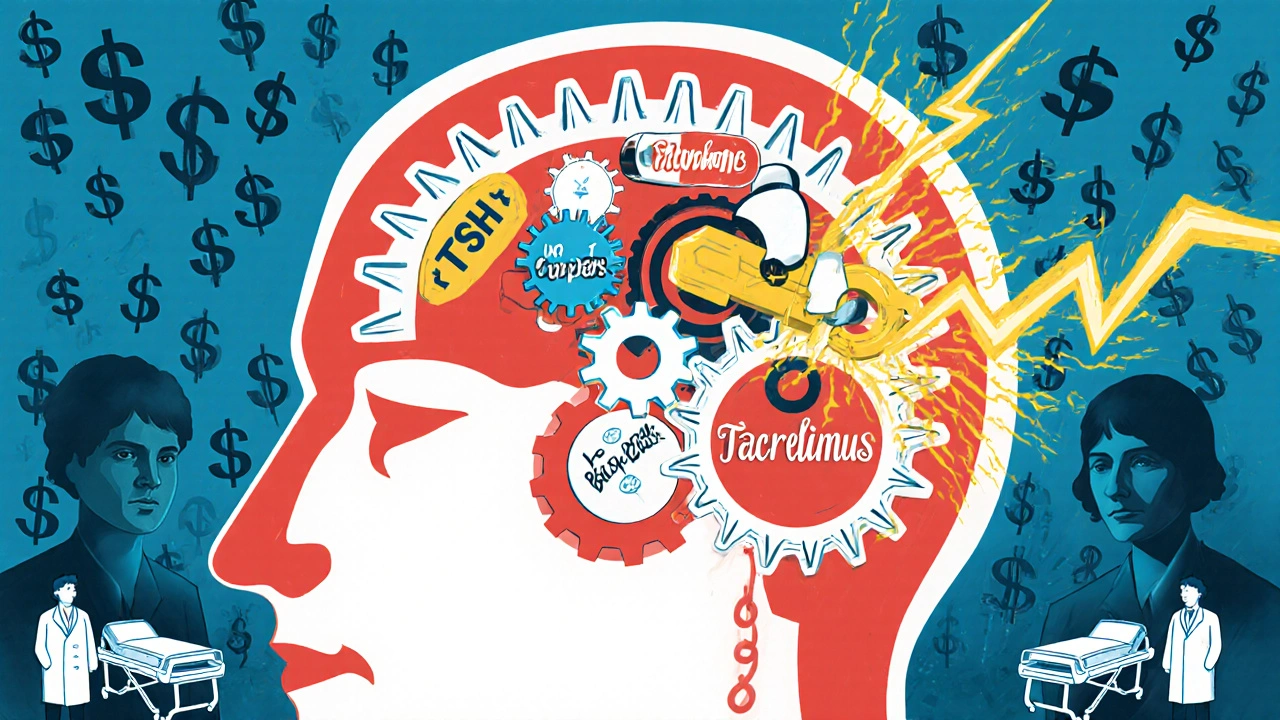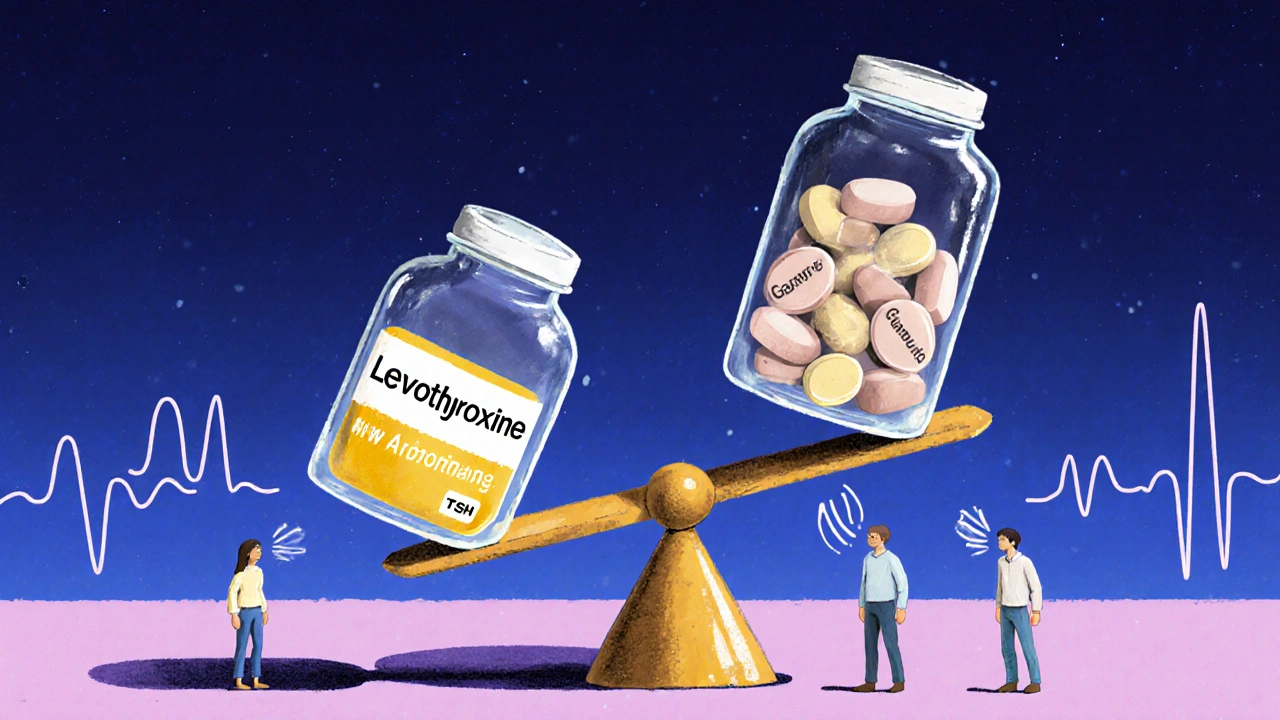When your doctor prescribes a drug like levothyroxine, warfarin, or tacrolimus, you might assume it doesn’t matter if you get the brand name or the cheaper generic. But for NTI drugs, that assumption can be dangerous. NTI stands for Narrow Therapeutic Index - meaning the difference between a dose that works and one that causes harm is tiny. A 5% change in blood levels might mean your seizures return, your blood clots, or your transplant gets rejected. That’s why switching between brand and generic versions isn’t like switching from one brand of aspirin to another.
What Makes a Drug an NTI Drug?
Not all medications are created equal when it comes to safety margins. The FDA defines NTI drugs as those where small changes in blood concentration can lead to serious side effects or treatment failure. These aren’t rare oddities - they’re critical medicines used by millions. Levothyroxine, used for hypothyroidism, is the most common. Warfarin, a blood thinner, is another. Tacrolimus, used after organ transplants, and certain antiepileptics like phenytoin and carbamazepine round out the list. There are roughly 15-20 drugs in this category, though the FDA doesn’t publish an official list.
The reason these drugs are so sensitive comes down to pharmacokinetics. They’re absorbed, distributed, metabolized, or cleared from the body in ways that make small differences in formulation matter. A generic version might have slightly different fillers, coatings, or manufacturing processes. For most drugs, that’s fine. For NTI drugs, it can mean your TSH level jumps from 3.2 to 7.1, your INR spikes from 2.5 to 4.8, or your tacrolimus level drops below the minimum needed to prevent rejection.
How Strict Are Generic Standards for NTI Drugs?
For regular generics, the FDA requires them to be within 80-125% of the brand’s blood concentration levels. That’s a wide range - and it’s fine for most drugs. But for NTI drugs, the rules changed in 2014. The FDA now uses a “scaled” bioequivalence approach. Instead of a fixed range, the acceptable window shrinks based on how variable the original drug is in the body. For some NTI drugs, the acceptable range is now 90-111%. That’s tighter than ever before.
Still, even with tighter standards, problems arise. A 2022 FDA analysis of over 17,500 levothyroxine patients found no major difference in thyroid hormone control between brand and generic. That sounds reassuring - until you look at the fine print. The study didn’t track patients who switched manufacturers multiple times. And it didn’t measure how many people had to go back to the brand after a bad reaction.
Real-world data tells a different story. On patient forums like Reddit’s r/Thyroid, about 30% of people who switched from Synthroid to a generic reported symptoms like fatigue, weight gain, or brain fog. About 5% had to return to the brand immediately. For warfarin users, 22% reported unstable INR levels after switching - meaning they needed more frequent blood tests and dose changes. For tacrolimus, the risk is even higher. Studies show that switching between generic versions can cause unpredictable drops in drug levels, putting transplant patients at risk of organ rejection.
Do Doctors and Pharmacists Agree on Substitution?
There’s a gap between what guidelines say and what happens in practice. The FDA insists that all AB-rated generics are safe to substitute. But many clinicians don’t feel that way. A 2022 survey of 710 pharmacists found that while 87% believed generics were effective and 94% thought they were safe, only 82% routinely substituted them for NTI drugs on first prescriptions. Why? Because they’ve seen the fallout.
Pharmacists in hospitals and clinics often follow a simple rule: once a patient is stable on a specific brand or generic manufacturer, don’t switch. That’s why many prescribers write “Dispense as Written” on NTI drug prescriptions. In 28 states, laws require pharmacists to notify the doctor or get patient consent before substituting NTI drugs. In other states, substitution happens automatically - and patients only find out when they feel off.
The American Academy of Neurology, the American Society of Health-System Pharmacists, and other groups all recommend caution. They don’t say generics are unsafe - they say the risk isn’t worth it when stability matters more than cost. One pharmacist in Cleveland told a case study: “After a patient switched generic tacrolimus manufacturers, his level dropped 40%. We had to hospitalize him. That’s not a theory - that’s what happens.”

When Is It Okay to Switch?
It’s not all or nothing. There are smart times to switch - and times you should avoid it at all costs.
If you’re just starting treatment, a generic is often the best first choice. It’s cheaper, and you’re still figuring out your dose. Many insurance plans now require you to try a generic first. If it works, great. If not, you can switch to brand.
But if you’ve been stable on a specific brand or generic version for months or years? Don’t switch. Not because the generic is inferior - but because your body has adapted to that exact formulation. Even switching from one generic to another generic can cause problems. One patient on levothyroxine switched from a $5 generic to a $7 generic and suddenly felt dizzy and heart palpitations. Her TSH went from 2.1 to 6.9. She went back to the original generic, and her symptoms vanished.
Also avoid switching during major life events: pregnancy, after surgery, during chemotherapy, or if you’re on multiple medications. Your body is already under stress. Don’t add drug instability to the mix.
What Should You Do If You’re Already on an NTI Drug?
Here’s a simple action plan:
- Check your prescription. Is it labeled with a brand name like Synthroid, Coumadin, or Prograf? Or does it say “levothyroxine sodium” or “warfarin sodium”? If it’s generic, find out which manufacturer makes it. The label should say something like “Made by Teva” or “Manufactured by Mylan.”
- Don’t let your pharmacy switch manufacturers without telling you. Ask them to notify you if the generic changes. Many pharmacies will do this if you ask.
- Keep a log. Note how you feel, your weight, sleep, energy, and any new symptoms. For warfarin users, track your INR values. For thyroid patients, note your TSH and free T4 levels.
- If you notice a change after a switch - fatigue, mood swings, irregular heartbeat, seizures - contact your doctor immediately. Don’t wait. These changes can be serious.
- Ask your doctor to write “Dispense as Written” or “Brand Necessary” on your prescription if you’re stable. This legally blocks automatic substitution in most states.
Insurance companies push generics because they save money. But they don’t pay for ER visits, hospitalizations, or missed work when a switch goes wrong. You’re the one who pays the price in symptoms - not them.

The Bigger Picture: Cost vs. Risk
Generic NTI drugs save patients hundreds of dollars a year. Levothyroxine generics cost $4-$15 monthly. The brand can be $30-$60. That’s real money. But the cost of getting it wrong? A thyroid storm. A stroke. A rejected kidney. Those aren’t just medical emergencies - they’re life-changing events.
There’s no perfect answer. The FDA says generics are safe. The data mostly supports that. But real people - real bodies - don’t always behave like study populations. Some people are more sensitive. Some manufacturers are more consistent. And once you find a version that works, it’s not worth gambling with.
The trend is moving toward more generics. By 2025, experts predict most NTI drugs will be safely interchangeable. But we’re not there yet. For now, the safest choice isn’t always the cheapest. It’s the one that keeps you stable, predictable, and safe.
Final Thought: Your Body, Your Rules
You don’t have to accept a switch just because it’s allowed. You don’t have to pay more just because you’re scared. You just need to be informed. Talk to your pharmacist. Ask your doctor. Track your symptoms. If you’ve found a version that works - stick with it. Your health isn’t a cost center. It’s your life.
Are all generic NTI drugs the same?
No. Even though two generics may be labeled the same - like “levothyroxine sodium” - they can be made by different companies with different fillers, coatings, or manufacturing methods. These small differences can affect how your body absorbs the drug. That’s why switching between generic brands can cause problems, even if both are FDA-approved.
Can I switch from brand to generic safely?
If you’re starting treatment, yes - generics are often the best first choice. But if you’ve been stable on brand for months or years, switching carries risk. Talk to your doctor first. Monitor your symptoms and lab values closely for 4-8 weeks after any switch. If you feel worse, go back.
Why do some states block automatic substitution for NTI drugs?
Because patient safety outweighs cost savings in these cases. In states with “non-substitution” laws, pharmacists must get permission from your doctor or your consent before switching you. This is because real-world data shows that even small changes in NTI drugs can lead to serious health events - especially in vulnerable populations like transplant patients or those with epilepsy.
How do I know if my drug is an NTI drug?
Common NTI drugs include levothyroxine, warfarin, tacrolimus, cyclosporine, phenytoin, carbamazepine, and digoxin. Check your prescription label or ask your pharmacist. If your doctor says your drug has a “narrow therapeutic window,” that’s another clue. The FDA doesn’t publish a full list, but these 15-20 drugs are widely recognized by experts.
Will my insurance cover the brand if I need it?
Many insurers require prior authorization for brand-name NTI drugs. If you’ve tried generics and had problems, your doctor can submit documentation showing the switch caused instability. Some plans will cover the brand if you’ve documented at least one failed generic attempt. Blue Cross Blue Shield of Kansas, for example, charges patients the full price difference if they choose brand over generic - unless a medical exception is approved.
What should I do if my pharmacy switches my NTI drug without telling me?
Call your pharmacy immediately and ask which manufacturer made your new prescription. Then contact your doctor. If you feel any new symptoms - fatigue, dizziness, irregular heartbeat, seizures - get your blood tested right away. For warfarin, check your INR. For thyroid drugs, check TSH. Don’t wait. Document everything. You have the right to be informed before a switch.
Next steps: Review your current NTI drug prescription. Note the manufacturer. Set a reminder to check your next refill. If the name changes, pause before taking it. Call your doctor. Ask for a lab test. Your stability isn’t just a number on a chart - it’s your health.





Jessica Correa
November 24, 2025 AT 03:23i switched from synthroid to a generic last year and felt like a zombie for months
fatigue, weight gain, brain fog-everything
my doctor said it was 'all in my head' until my tsh jumped to 8.2
went back to the brand and i’m human again
manish chaturvedi
November 25, 2025 AT 10:35in india, we rarely see brand-name ntis due to cost, but i’ve seen patients on warfarin struggle after switching generics
the lab reports show fluctuating inr, and the patients suffer silently
cost matters, but not at the cost of stability
Holly Schumacher
November 26, 2025 AT 12:27oh my god. this is the most important thing i’ve read all year.
the fda doesn’t care about your thyroid, your kidney, or your life-they care about profit margins and generic market share.
they call it 'bioequivalent' like that’s a magic word that erases biology.
my cousin’s transplant failed because they switched tacrolimus generics without telling her family.
she’s on dialysis now. this isn’t science. it’s corporate negligence dressed up as policy.
Michael Fitzpatrick
November 28, 2025 AT 09:14i totally get where you’re coming from, and honestly, i think most people don’t realize how delicate these meds are.
my mom’s been on levothyroxine for 15 years and she’s been on the same generic since 2018-never switched, never had an issue.
but when the pharmacy tried to swap her to a different one last year, she started getting heart palpitations and couldn’t sleep.
they had to call the doctor, get her back on the original, and now they’ve got a note in her file to never switch again.
it’s not about brand loyalty-it’s about consistency. your body remembers the formula.
Shawn Daughhetee
November 29, 2025 AT 07:49my sister switched generics for her seizure med and had a seizure at work
they didn’t even know why until her bloodwork came back
the new generic had a different filler that messed with absorption
now she only takes the one brand her neurologist prescribes
they don’t tell you this stuff until it’s too late
Justin Daniel
November 29, 2025 AT 12:43so like… if you’re on a generic and it works, don’t touch it.
if you’re starting out, go generic, save cash.
but if you’ve been stable for a year? don’t gamble.
it’s not that generics are bad, it’s that your body is already calibrated to one version.
switching is like changing your car’s tires mid-roadtrip-sometimes you’re fine, sometimes you crash.
Melvina Zelee
November 30, 2025 AT 12:29my tsh went from 2.5 to 7.1 after switching generics and i thought i was just depressed
turns out i was hypothyroid again
now i write 'dispense as written' on every script
and i tell my pharmacist if they switch it i’ll walk out
my health is not your inventory problem
steve o'connor
December 1, 2025 AT 07:19in ireland, we don’t have automatic substitution for ntis-pharmacists have to check with the prescriber.
it’s a small thing, but it saves lives.
the system isn’t perfect, but at least someone’s asking: 'is this safe for this person?'
maybe the us should take a page from that book.
ann smith
December 2, 2025 AT 06:15thank you for writing this with such care.
so many people feel alone in this struggle, but you’ve given us a roadmap.
track your labs, ask questions, demand consistency.
you are not being 'difficult'-you’re being smart.
your body is worth the extra step.
❤️
james lucas
December 3, 2025 AT 10:32my dad’s on warfarin and he switched generics twice last year
first time his inr went to 5.8, he almost bled out
second time it dropped to 1.2, he got a blood clot in his leg
now he only takes coumadin and the pharmacy has to call his doctor every time
insurance tried to make him switch again last month
we told them to go screw themselves
his life is not a spreadsheet
New Yorkers
December 4, 2025 AT 23:21you’re all just scared of saving money.
if your body can’t handle a generic, maybe you’re not meant to live in the real world.
the fda approves these drugs for a reason.
you’re not special.
stop being dramatic.
take the generic.
get over it.
David Cunningham
December 5, 2025 AT 09:51in australia we have a similar system to ireland-pharmacists have to notify you before switching ntis.
but honestly? most people don’t even know what ntis are.
we need better public education.
not just for patients, but for pharmacists and even doctors.
it’s not just about the drug-it’s about the system failing to communicate risk.
we can do better.